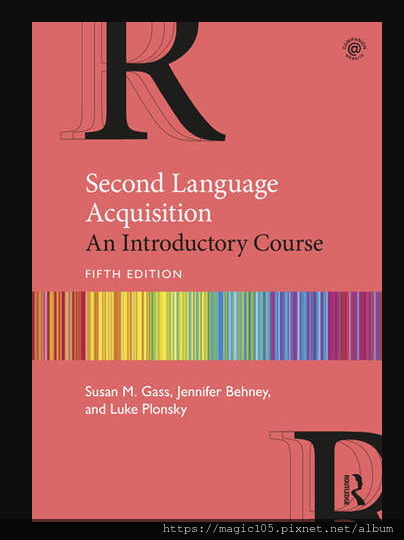上學期修了第二語言習得研究,老師開了一本原文書。相關資訊筆記如下"
![]() 書籍網站
書籍網站
This textbook is supported with a Companion Website containing instructor and student resources including PowerPoint slides, exercises, stroop tests, flashcards, audio and video
https://routledgetextbooks.com/textbooks/9781138743427/default.php
![]() Second Language Acquisition: An Introductory Course (5th Edition)
Second Language Acquisition: An Introductory Course (5th Edition)
By Susan M. Gass, Jennifer Behney, Luke Plonsky

![]() ABOUT THE BOOK
ABOUT THE BOOK
This edition provides pedagogical tools that encourage students to reflect upon the experiences of second language learners. As with previous editions, discussion questions and problems at the end of each chapter help students apply their knowledge, and a glossary defines and reinforces must-know terminology. This clearly written, comprehensive, and current textbook, by Susan Gass, Jennifer Behney, and Luke Plonsky, is the ideal textbook for an introductory SLA course in second language studies, applied linguistics, linguistics, TESOL, and/or language education programs.
![]() Chapter One: Introduction
Chapter One: Introduction
1.1 THE STUDY OF SECOND LANGUAGE ACQUISITION
1.2 DEFINITIONS
1.3 THE NATURE OF LANGUAGE
1.3.1 Semantics
1.3.2 Pragmatics
1.3.3 Syntax
1.3.4 Morphology and the Lexicon
1.3.5 Sound Systems
1.4 THE NATURE OF NONNATIVE SPEAKER KNOWLEDGE
1.5 CONCLUSION
![]() Chapter Three: The Role of the Native Language - A Historical Overview
Chapter Three: The Role of the Native Language - A Historical Overview
3.1 INTRODUCTION
3.2 BEHAVIORISM
3.2.1 Linguistic Background
3.2.2 Psychological Background
3.3 CONTRASTIVE ANALYSIS HYPOTHESIS
3.4 ERROR ANALYSIS
3.5 CONCLUSION
Part Three: A Focus on Form - Language Universals
![]() Chapter Six: Formal Approaches to SLA
Chapter Six: Formal Approaches to SLA
6.1 INTRODUCTION
6.2 UNIVERSAL GRAMMAR
6.2.1 Initial State
6.2.1.1 Fundamental Difference Hypothesis
6.2.1.2 Access to UG Hypothesis
6.2.2 UG Principles
6.2.3 UG Parameters
6.2.4 Minimalist Program
6.2.5 Falsification
6.3 TRANSFER: THE GENERATIVE/UG PERSPECTIVE
6.3.1 Levels of Representation
6.3.2 Clustering
6.3.3 Learnability
6.4 THE FUNDAMENTAL DIFFERENCE HYPOTHESIS REVISED
6.5 SEMANTICS AND THE SYNTAX–SEMANTICS INTERFACE HYPOTHESIS
6.5.1 Semantics
6.5.2 Syntax and Semantics: The Interface Hypothesis
6.6 PHONOLOGY
6.6.1 Markedness Differential Hypothesis
6.6.2 Similarity/Dissimilarity: Speech Learning Model
6.6.3 Optimality Theory
6.6.4 Ontogeny Phylogeny Model
6.7 CONCLUSION
![]() Chapter Four: The Transition Period
Chapter Four: The Transition Period
4.1 INTRODUCTION
4.2 FIRST LANGUAGE ACQUISITION
4.2.1 Words
4.2.2 Sounds and Pronunciation
4.2.3 Syntax
4.2.4 Morphology
4.3 CHILD L2 ACQUISITION
4.4 CHILD L2 MORPHEME ORDER STUDIES
4.5 ADULT L2 MORPHEME ORDER STUDIES
4.6 THE MONITOR MODEL
4.6.1 The Acquisition-Learning Hypothesis
4.6.2 The Natural Order Hypothesis
4.6.3 The Monitor Hypothesis
4.6.4 The Input Hypothesis
4.6.5 The Affective Filter Hypothesis
4.6.6 Limitations
4.7 CONCLUSION
![]() Chapter Five: Alternative Approaches to the Role of Previously Known Languages
Chapter Five: Alternative Approaches to the Role of Previously Known Languages
5.1 REVISED PERSPECTIVES ON THE ROLE OF THE NATIVE LANGUAGE
5.1.1 Avoidance
5.1.2 Differential Learning Rates
5.1.3 Different Paths
5.1.4 Overproduction
5.1.5 Predictability/Selectivity
5.1.6 L1 Influences in L2 Processing
5.1.7 Morpheme Order
5.2 CONCLUSION
Part Three: A Focus on Form - Language Universals
![]() 小組報告
小組報告
![]() Chapter Ten: Psycholinguistic Approaches to Learning
Chapter Ten: Psycholinguistic Approaches to Learning
10.1 INTRODUCTION
10.2 MODELS OF LANGUAGE PRODUCTION
10.3 PROCESSABILITY THEORY
10.4 PROCESSING OF INPUT
10.4.1 Input Processing
10.4.2 Processing Determinism
10.4.3 Autonomous Induction Theory
10.4.4 Shallow Structure Hypothesis
10.5 EMERGENTIST MODELS
10.5.1 Competition Model
10.5.2 Frequency-based Accounts
10.6 COMPLEX DYNAMIC SYSTEMS
10.7 SKILL ACQUISITION THEORY
10.8 CONCLUSION
![]() Chapter Eleven: Psycholinguistic Constructs and Knowledge Types
Chapter Eleven: Psycholinguistic Constructs and Knowledge Types
11.1 INTRODUCTION
11.2 INFORMATION PROCESSING
11.2.1 Automaticity
11.2.2 Restructuring
11.2.3 U-shaped Learning
11.2.4 Attention
11.2.5 Working Memory
11.2.6. Salience
11.2.7 Priming
11.3 KNOWLEDGE TYPES
11.3.1 Acquisition/Learning
11.3.2 Declarative/Procedural
11.3.3 Implicit/Explicit
11.3.4 Representation/Control
11.4 INTERFACE OF KNOWLEDGE TYPES
11.4.1 No Interface
11.4.2 Weak Interface
11.4.3 Strong Interface
11.5 CONCLUSION
![]() Chapter Fifteen: Learner-internal Influences
Chapter Fifteen: Learner-internal Influences
15.1 INTRODUCTION
15.2 THE INFLUENCE OF PSYCHOLOGY IN SLA
15.3 METHODOLOGICAL CONSIDERATIONS
15.4 AGE DIFFERENCES
15.5 APTITUDE
15.6 MOTIVATION
15.6.1 Motivation as a Function of Time and Success
15.6.2 Changes over Time
15.6.3 The L2 Motivational Self System
15.6.4 Influence of Success on Motivation and Demotivation
15.7 AFFECT
15.7.1 Anxiety
15.7.2 Other Emotional Variables
15.8 PERSONALITY
15.8.1 Extroversion and Introversion
15.8.2 Grit
15.9 LEARNING STRATEGIES
15.10 CONCLUSION





 留言列表
留言列表